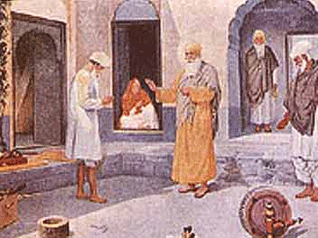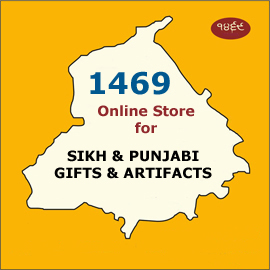Kids' Corner
Bhai Lalo:
Living Sikhi, Lesson Seventeen
by VERONICA SIDHU
BHAI LALO
Lesson Objectives:
1 To understand how brave Guru Nanak was to eat a meal with Bhai Lalo.
2 To see what an important meaning this act had both in world history and in the history of religion.
3 To understand the meaning of "liberation".
Teachers, ask the students to say the Sikh greeting with you; then fold hands and do simran with the students.
Read pages 51-56.
We have studied a little about Punjab. It is also important to know some facts about the times of Guru Nanak to appreciate the great importance of this story to the whole world. The caste system was very prominent in all people's lives in those days in India. In those days a high caste person had to take a bath and change clothes if even the shadow of an outcaste fell across him. To actually eat with a low caste person was unheard of and, to many, disgusting.
Why do you think Guru Nanak risked making prominent people disgusted? (Pause for answers.) Right! He had just come from the God World, Sach Khund, where he did not find any high caste or low caste people at all. Only the love of God. Right! He wanted people to know that God is One and loves all people. So how important was caste in the Realm of Truth? (Pause for answers.)
Guru Nanak had an important mission. He knew that the time had come for all people on earth to learn about the ONE God who lives in the FORMLESS world who is the Father and Mother to ALL. If God is the Father and Mother to all, then, of course, all men and women are brothers and sisters, and should behave like brothers and sisters to each other. All men and women are equal! These were very unusual ideas at that time in history. This was the beginning of a social revolution that has gone around the world and continues even today! Other messengers had spoken about compassion (Buddha) and love and forgiveness (Jesus) that were revolutionary ideas in those times. But no one had tackled the social structure like Guru Nanak had done when he chose to eat a meal with Bhai Lalo.
Social structures are the ways people behave in groups. Sometimes these structures are laws governing the people's behavior, sometimes they are traditions passed down from parents to children, and sometimes they are religious precepts passed down by the religious leaders. The caste system in India is an ancient social structure passed down by both religious leaders and families. We will study more about it in the next lesson.But there were many other social systems and structures in the world (and still are) that needed to change if people were to be free in their minds and hearts to go to the Realm of Truth. Slavery, feudalism, royalty, priesthood, dynasties, etc., all of these social institutions put great value on the position a person holds in society and institutions. In these systems, power and/or money is protected for a few at the top, people are far from being treated equally, and many times they are excuses to treat people very badly. Many times in these systems, the people on the top think they are more important to God and the people at the bottom think they are not capable of reaching God by themselves and need the people at the top to speak to God for them.
Since almost no one in those days knew about the Realm of Truth, no one in those days knew how to act fairly to one another on earth. Wherever he traveled, Guru Nanak not only recited his poems and songs about the Realm of Truth in the language of the people of those times and of where they lived, he modeled for everyone the way to act if we know about that world. Guru Nanak shocked many people into thinking about this reality in truth - that all men and women are brothers and sisters.
In Truth, people really are Children of God no matter what job they hold, or what other people think of them. Yet because no one had talked to them about the Realm of Truth before in their own language, people had become stuck in their notions, the traditional ideas, of who they were. They were told that, because they were a priest, a king or a farmer or a beggar, they could, or could not, have their prayers heard by God, let alone merge with God while on Earth. Guru Nanak, by bringing this knowledge into the earthly dimension, opened a gate, turned on a light that would guide many, many others to spread these truths throughout the world. Guru Nanak brought the possibility of freedom, of liberation in the everyday as well as the religious life of ordinary people everywhere.
True freedom, liberation, is in the realization that each of us, each and every soul, can merge with God like a drop of water in the ocean. In God there is everything! Merging with God is liberation - being free of all the ideas we have about ourselves based on our birth or occupation that hold us back from the Ocean of Love that is God.
How do we act if we know that God is One? (Pause for answers.)
Homework: Is there a boy or girl in your class who has very few, if any, friends? Say "Hi" every time you see this student. At least once a week, sit with this student during lunch, or play on the playground with this student. Write down what happened when you did these things.
Shabad: Sa rasna dhan dhan hai
Alternate Shabad: Lakh Khushiaan Patshaa-i-aan
August 10, 2010




